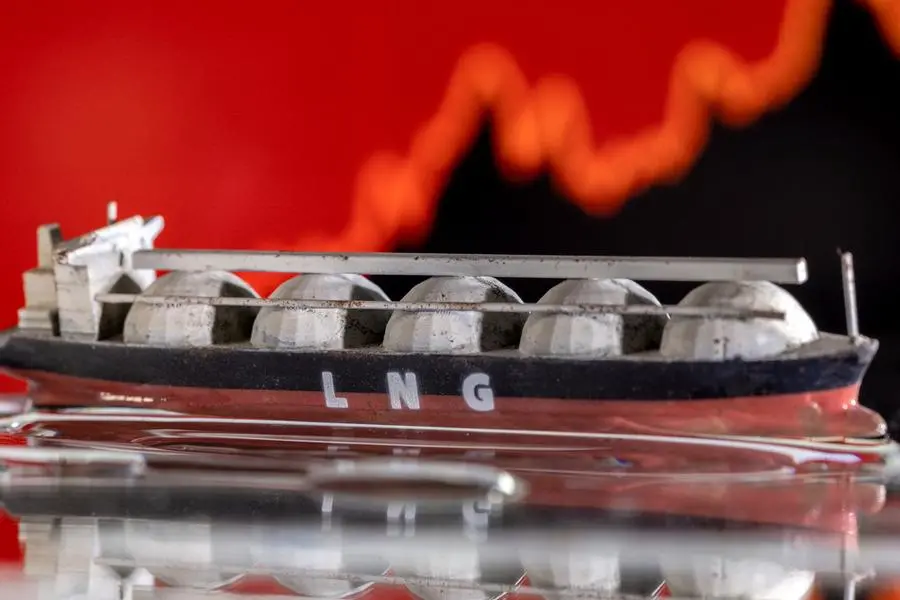PHOTO
LONDON - Europe’s gas storage has got off to an unusually slow start to the refill season, narrowing the record seasonal surplus inherited from last winter and boosting prices back well above the long-term average.
Inventories in the European Union and the United Kingdom have accumulated by just 148 terawatt-hours (TWh), or 2.1 TWh per day, since March 31, data from Gas Infrastructure Europe (GIE) show.
The refill was the second-slowest since 2012 and well below the prior ten-year seasonal average of 206 TWh, or 2.9 TWh per day.
Europe emerged from the warm winter of 2023/24 with a record amount of gas still in storage, so a relatively slow refill was required to ensure space did not run out before the onset of winter 2024/25.
But the unusually slow start to the refill season has already whittled away some of the surplus and reduced the probability of space running out.
Stocks were 219 TWh (+37% or +1.57 standard deviations) above the prior ten-year average on June 9, but the surplus had narrowed from 277 TWh (+70% or +2.03 standard deviations) when winter ended on March 31.
Storage was already 72% full on June 9, which was 17 percentage points above the ten-year average, but the surplus had narrowed from 22 percentage points on March 31.
Based on seasonal patterns over the last decade, inventories are on course to reach 1,223 TWh before the end of the refill season.
This exceeds the technical capacity of the system, which is around 1,145 TWh, so refilling will have to remain slow for some weeks or months more.
But the projected end-of-summer fill has already fallen steadily from 1,280 TWh on March 31 and the probability of overfilling has declined sharply.
Chartbook: Europe gas storage and prices
The reduced risk of overfilling has filtered through into higher futures prices for summer 2024 and tighter calendar spreads for the end of the refill season.
Front-month Dutch TTF futures prices have risen to an average of 34 euros per megawatt-hour (MWh) so far in June, putting them in the 77th percentile for all months since 2010 after adjusting for inflation.
Front-month prices have climbed from an average of just 26 euros in February, which was in only the 43rd percentile in real terms.
The calendar spread between October and November 2024, spanning the end of the refill season and start of the winter drawdown, has tightened from a contango of almost 3 euros in December and January to 2.20 euros so far in June.
Lower international gas prices have encouraged more liquefied natural gas (LNG) purchasing by price-sensitive buyers in south and east Asia, diverting cargoes away from Europe and helping erode the surplus.
Severe heatwaves across India, Bangladesh, southeast Asia and south China have also boosted gas consumption by generators to meet air-conditioning and refrigeration demand, pulling more LNG away from Europe.
Since the summer of 2023, northeast Asia’s LNG buyers have been prepared to pay a premium over their counterparts in northwest Europe, but the premium has increased significantly since the end of winter 2023/24.
LNG futures prices for gas to be delivered to northeast Asia in July 2024 have been trading more than 3 euros per MWh above European benchmark prices since the start of April.
So far, Europe’s surplus has kept it on the sidelines and allowed more LNG to be diverted to gas-hungry buyers in south and east Asia.
Europe’s buyers are likely to remain relatively inactive for several more months given that inventories are still well above normal.
But as the surplus gradually erodes, competition between Europe and Asia for LNG is likely to re-emerge before the end of 2024, and prices could rise sharply if a cold winter across both ends of Eurasia leads to a scramble for the last remaining uncommitted cargoes.
John Kemp is a Reuters market analyst. The views expressed are his own. Follow his commentary on X https://twitter.com/JKempEnergy
(Editing by Mark Potter)












